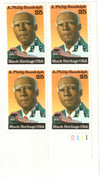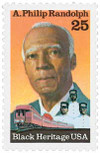
# 2402 - 1989 25c Black Heritage: A. Philip Randolph
U.S. #2402
1989 25¢ A. Philip Randolph
Black Heritage
- 12th stamp in Black Heritage Series
- Issued for Randolph’s 100th birthday
- Pictures Randolph and Pullman porters, whose union he led
Stamp Category: Commemorative
Series: Black Heritage
Value: 25¢, first-class rate
First Day of Issue: February 3, 1989
First Day City: New York City, New York
Quantity Issued: 151,675,000
Printed by: Bureau of Engraving and Printing
Printing Method: Photogravure
Format: Panes of 50 in sheets of 200
Perforations: 11
Why the stamp was issued: To commemorate Randolph’s 100th birthday and mark the start of Black History Month. The USPS chose to bend its 10-year statute for this stamp. At the time, no one other than a president could be honored with a stamp until 10 years after their death. This stamp was issued 102 days short of 10 years after Randolph’s death. A few people criticized the choice, saying there must be plenty of other people to choose from that meet the criteria. However, the USPS said that the rule doesn’t require exactly 10 years to pass. They had made the same exception a few years earlier for Jackie Robinson.
About the stamp design: This stamp was designed by Thomas Blackshear, who’d also designed the Jean Baptiste Pointe de Sable and James Weldon Johnson Black Heritage stamps. Blackshear based his gouache and colored pencil portrait on a photo provided by the Randolph Institute. The small inset image pictures a passenger train and three Pullman porters.
About the Black Heritage Series: The Black Heritage Series began on February 1, 1978, with the issue of the 13¢ Harriet Tubman stamp (US #1744). Since then, the USPS has issued a new stamp in the series every year. A number of them have even been released in February in recognition of Black History month. As of 2023, it was the USPS’s longest-running stamp series of all time.
History the stamp represents: Asa Philip Randolph was born on April 15, 1889, in Crescent City, Florida. Randolph was a respected and outspoken proponent of the rights of minority labor. He was greatly feared by his opponents, not because of his temperament, but because of his power to create change.
Randolph was a bright student, and most enjoyed his classes in literature, drama, and public speaking. He played on the school’s baseball team, sang in the school choir, and was valedictorian of his high school’s graduating class in 1907. Randolph spent time after graduation singing and acting. But once he read W.E.B. Du Bois’s The Souls of Black Folk, he decided that the most important thing he could do would be to dedicate his attention to fighting for social equality.
Randolph moved to New York City in 1911 and worked a variety of jobs while studying social science at City College. Randolph supported the Industrial Workers of the World and opened an employment office that helped people from the south get the training they needed for jobs in the north. He also encouraged them to join trade unions.
Randolph organized his first labor union in 1917, for elevator operators. Two years later, he was made president the National Brotherhood of Workers of America, a union for shipyard and dock workers in Virginia. In 1925, Randolph was elected president of the Brotherhood of Sleeping Car Porters (BSCP), a union for workers at the Pullman Company, which built railroad cars. At the time, quickly expanding railroads created a need for workers, but they were underpaid and suffered unsafe working conditions.
Within a year of Randolph taking over, the BSCP enrolled 51% of porters. The union struggled for a few years, and had to cancel a strike when they learned the company may have had 5,000 replacement workers ready. Then after Franklin Roosevelt became president, the Railway Labor Act was amended in 1934 and porters were granted rights under federal law. The BSCP membership soared to over 7,000 and the Pullman Company finally entered negotiations and signed a contract with the union in 1927. Workers received significant pay increases, a shorter workweek, and overtime pay.
Randolph’s work with the BSCP brought him national attention in the Civil Rights movement. In 1941, he, along with Bayard Rustin and A.J. Muste, suggested a march on Washington to protest discrimination, segregation, and lynching. Randolph was inspired by Mahatma Gandhi’s peaceful protests and believed the same tactics could work in the Civil Rights movement. Randolph planned a 50,000-person march in the capital, but President Roosevelt then signed Executive Order 8802, also known as the Fair Employment Act, which barred discrimination in the defense industry. While some activists were disappointed that the law didn’t go far enough, it was still considered an important early civil rights victory.
Randolph continued the fight, helping to establish the Committee Against Jim Crow in Military Service, which later became the League for Non-Violent Civil Disobedience. Pressure from Randolph and his supporters encouraged President Harry Truman to sign Executive Order 9981, which prohibited racial segregation in the armed forces.
Randolph went on to co-found the Leadership Conference on Civil Rights, which was influential in the passage of every civil rights law from 1957 on. He also worked with Martin Luther King Jr. to create the Prayer Pilgrimage for Freedom as well as Youth Marches for Integrated Schools. Then in 1961, Randolph worked with Bayard Rustin to plan the March on Washington for Jobs and Freedom. The march occurred on August 28, 1963, and was one of the largest human rights rallies in US history, with an estimated 250,000 participants. The march has been credited with encouraging the passage of the Civil Rights Act of 1964.
Randolph retired from the BCSP in 1968 and suffered declining health until his death on May 16, 1979. He earned many awards during his lifetime, including a Presidential Medal of Freedom. There are also many streets and buildings, and an Amtrak sleeping car named in his honor.
U.S. #2402
1989 25¢ A. Philip Randolph
Black Heritage
- 12th stamp in Black Heritage Series
- Issued for Randolph’s 100th birthday
- Pictures Randolph and Pullman porters, whose union he led
Stamp Category: Commemorative
Series: Black Heritage
Value: 25¢, first-class rate
First Day of Issue: February 3, 1989
First Day City: New York City, New York
Quantity Issued: 151,675,000
Printed by: Bureau of Engraving and Printing
Printing Method: Photogravure
Format: Panes of 50 in sheets of 200
Perforations: 11
Why the stamp was issued: To commemorate Randolph’s 100th birthday and mark the start of Black History Month. The USPS chose to bend its 10-year statute for this stamp. At the time, no one other than a president could be honored with a stamp until 10 years after their death. This stamp was issued 102 days short of 10 years after Randolph’s death. A few people criticized the choice, saying there must be plenty of other people to choose from that meet the criteria. However, the USPS said that the rule doesn’t require exactly 10 years to pass. They had made the same exception a few years earlier for Jackie Robinson.
About the stamp design: This stamp was designed by Thomas Blackshear, who’d also designed the Jean Baptiste Pointe de Sable and James Weldon Johnson Black Heritage stamps. Blackshear based his gouache and colored pencil portrait on a photo provided by the Randolph Institute. The small inset image pictures a passenger train and three Pullman porters.
About the Black Heritage Series: The Black Heritage Series began on February 1, 1978, with the issue of the 13¢ Harriet Tubman stamp (US #1744). Since then, the USPS has issued a new stamp in the series every year. A number of them have even been released in February in recognition of Black History month. As of 2023, it was the USPS’s longest-running stamp series of all time.
History the stamp represents: Asa Philip Randolph was born on April 15, 1889, in Crescent City, Florida. Randolph was a respected and outspoken proponent of the rights of minority labor. He was greatly feared by his opponents, not because of his temperament, but because of his power to create change.
Randolph was a bright student, and most enjoyed his classes in literature, drama, and public speaking. He played on the school’s baseball team, sang in the school choir, and was valedictorian of his high school’s graduating class in 1907. Randolph spent time after graduation singing and acting. But once he read W.E.B. Du Bois’s The Souls of Black Folk, he decided that the most important thing he could do would be to dedicate his attention to fighting for social equality.
Randolph moved to New York City in 1911 and worked a variety of jobs while studying social science at City College. Randolph supported the Industrial Workers of the World and opened an employment office that helped people from the south get the training they needed for jobs in the north. He also encouraged them to join trade unions.
Randolph organized his first labor union in 1917, for elevator operators. Two years later, he was made president the National Brotherhood of Workers of America, a union for shipyard and dock workers in Virginia. In 1925, Randolph was elected president of the Brotherhood of Sleeping Car Porters (BSCP), a union for workers at the Pullman Company, which built railroad cars. At the time, quickly expanding railroads created a need for workers, but they were underpaid and suffered unsafe working conditions.
Within a year of Randolph taking over, the BSCP enrolled 51% of porters. The union struggled for a few years, and had to cancel a strike when they learned the company may have had 5,000 replacement workers ready. Then after Franklin Roosevelt became president, the Railway Labor Act was amended in 1934 and porters were granted rights under federal law. The BSCP membership soared to over 7,000 and the Pullman Company finally entered negotiations and signed a contract with the union in 1927. Workers received significant pay increases, a shorter workweek, and overtime pay.
Randolph’s work with the BSCP brought him national attention in the Civil Rights movement. In 1941, he, along with Bayard Rustin and A.J. Muste, suggested a march on Washington to protest discrimination, segregation, and lynching. Randolph was inspired by Mahatma Gandhi’s peaceful protests and believed the same tactics could work in the Civil Rights movement. Randolph planned a 50,000-person march in the capital, but President Roosevelt then signed Executive Order 8802, also known as the Fair Employment Act, which barred discrimination in the defense industry. While some activists were disappointed that the law didn’t go far enough, it was still considered an important early civil rights victory.
Randolph continued the fight, helping to establish the Committee Against Jim Crow in Military Service, which later became the League for Non-Violent Civil Disobedience. Pressure from Randolph and his supporters encouraged President Harry Truman to sign Executive Order 9981, which prohibited racial segregation in the armed forces.
Randolph went on to co-found the Leadership Conference on Civil Rights, which was influential in the passage of every civil rights law from 1957 on. He also worked with Martin Luther King Jr. to create the Prayer Pilgrimage for Freedom as well as Youth Marches for Integrated Schools. Then in 1961, Randolph worked with Bayard Rustin to plan the March on Washington for Jobs and Freedom. The march occurred on August 28, 1963, and was one of the largest human rights rallies in US history, with an estimated 250,000 participants. The march has been credited with encouraging the passage of the Civil Rights Act of 1964.
Randolph retired from the BCSP in 1968 and suffered declining health until his death on May 16, 1979. He earned many awards during his lifetime, including a Presidential Medal of Freedom. There are also many streets and buildings, and an Amtrak sleeping car named in his honor.











